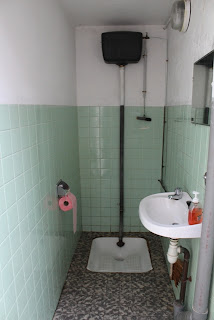With dry and sunny conditions we took one more hike to the Vercors, the mountain chain I can see from our kitchen window and where much of our cheese comes from. We took a tram to the end of the line and from there started our hike up to about 1090 meters. It was an easy hike (not steep or rocky) and had many interesting things to see.
Several waterfalls at the start of our hike
We were pushed off the path by a herd of sheep making its way down the mountain. A shepherd was in the lead and a woman at the end with a couple of dogs to keep them on the right path. With snow predicted for this weekend, I think the farmers decided to finally bring the sheep down to where they could go indoors.
 A traditional farmhouse in the Vercors. The left side is the "house" and the right side is for the animals. We were not sure if the right side was still used for this purpose.
A traditional farmhouse in the Vercors. The left side is the "house" and the right side is for the animals. We were not sure if the right side was still used for this purpose.For a different experience, this place was advertising "camping à la ferme"--camping on the farm in teepees and tents. Goats were grazing on the other side of the tents.
A final point of interest was a memorial to the French Resistance fighters of WWII. The Verscors was a center for the French Resistance until some 15,000 German troups came through the area and decimated the Resistance army, along with destroying farms and families.
We really didn't expect to see so much on our hike, but since the weather was nice and our initial destination of a farm up on the plateau came already at 11am, we decided to go further.
We are sad that this will be our last hike, but at the same time never thought we could hike this late into fall!
We really didn't expect to see so much on our hike, but since the weather was nice and our initial destination of a farm up on the plateau came already at 11am, we decided to go further.
We are sad that this will be our last hike, but at the same time never thought we could hike this late into fall!
















































